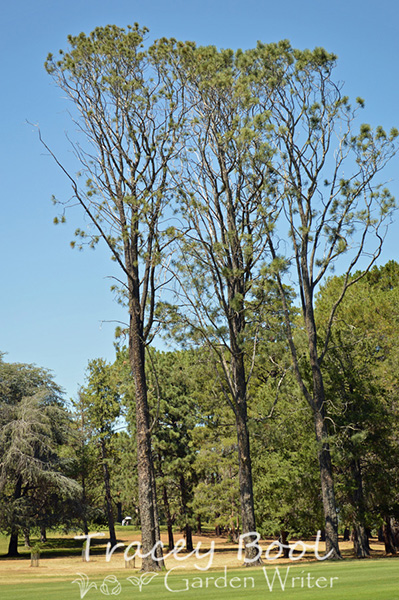|
Westbourne Woods Arboretum
(20 February 2014) I recently attended a guided walk in Westbourne Woods on the 20.02.2014, conducted by Friends of ACT Trees (FACTT) and presented by a well-respected local landscape architect and fellow tree enthusiast. The forest, Canberra’s oldest arboreta (established in 1914 and located within the Royal Canberra Golf Course grounds), currently contains 183 species of trees, all of which were selected and trialed for their potential as street and park specimens in the Canberra area. The walk took me on a fascinating journey, one that highlighted the majestic beauty, importance, and uses of trees in the landscape, and the fact that they, just as we do, have rich histories and stories to tell. There were three such trees that I found of particular interest: Maclura pomifera, commonly known as Osage orange, bow-wood and tennis ball tree, amongst others, is a fast growing deciduous tree up to 20m high and 12m wide. Originating from North America, this hardy species has a diverse range of applications both claimed and otherwise, such as: its use as a high quality, exceptionally strong timber in the manufacture of items such as tools, fence posts and bows; as a yellow-orange dye, which can be used as an alternative to more traditional fustic and aniline dyes; and its reputed, and possibly since confirmed, insect repelling qualities due to its containing felemol. Eucalyptus obliqua, or messmate stringybark, is a stately tree of up to 70m with thick, fissured, and often stringy bark, lovely glossy green foliage, and white flowers during late summer and early autumn. Generally a straight, single-trunked species, messmate stringybark can, however, take on a smaller, multi-stemmed form in more exposed sites. The tree’s light timber is used for general construction and makes for reasonable wood heater fuel. This Eucalypt was the first to be described as such in 1788 – the specimen was collected in 1777 during Cook’s third voyage. Pinus torreyana, the Torrey pine, is one of the rarest Pine species in the world, naturally occurring in only two locations in North America (cattle grazing, pest infestation, and pollution are contributing factors to this tree’s vulnerable status). A relatively small growing tree of around 8m – 15m with an open habit, the Torrey pine is a source of food and shelter for wildlife and it also provides protection for smaller growing understory plants. It is drought tolerant and grows well in exposed sites with sandy soils and poor nutrition. Aside from the specimens at Westbourne Woods, there is also a stand of Torrey Pines located at the Cotter Plots in Canberra. For more information on Westbourne Woods, I found the ACT Libraries website useful (search the Heritage Library/local history section: www.library.act.gov.au For more information on Friends of the Australian Capital Territory Trees and upcoming walks: https://sites.google.com/site/factacanberra/home |

